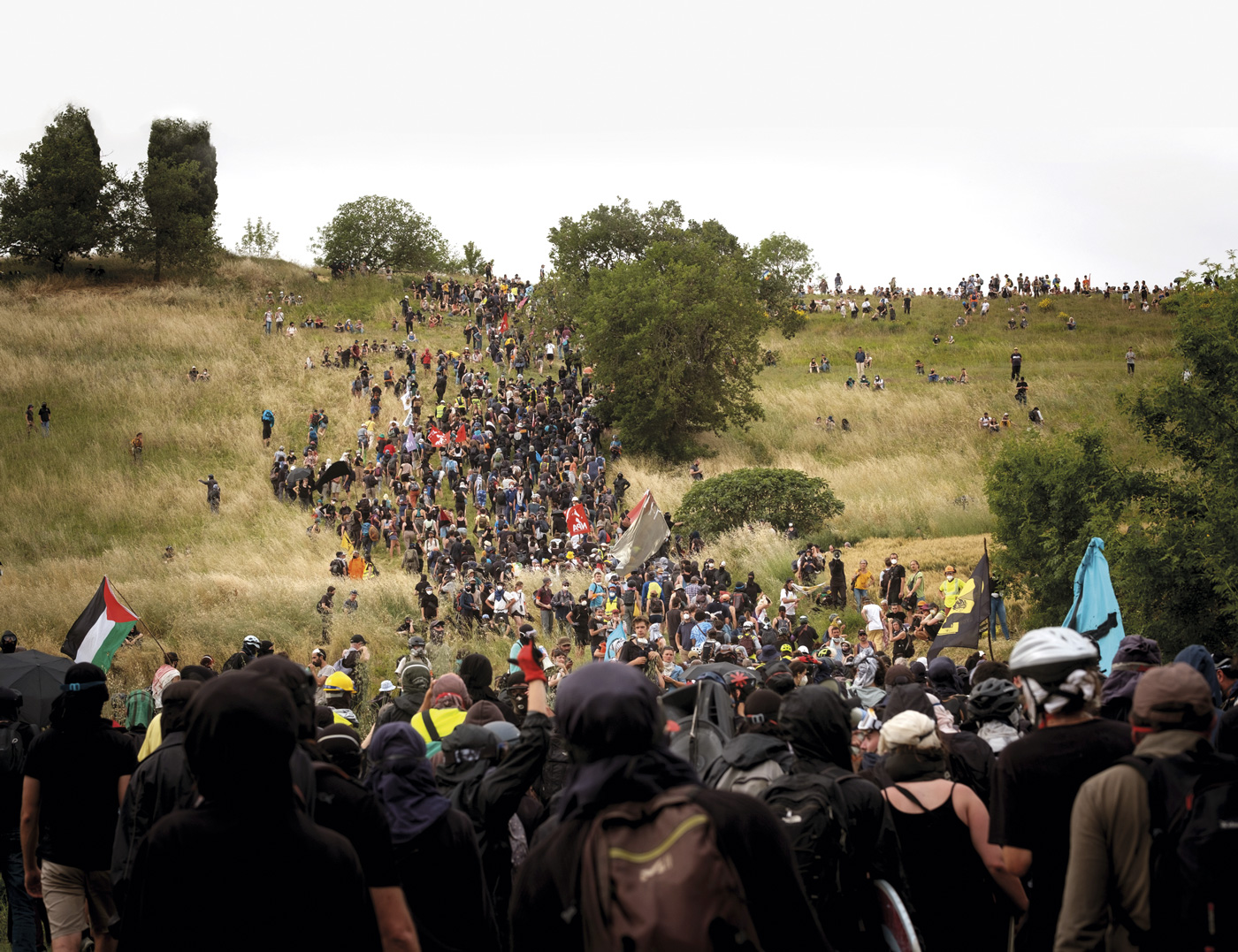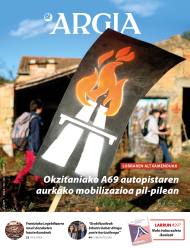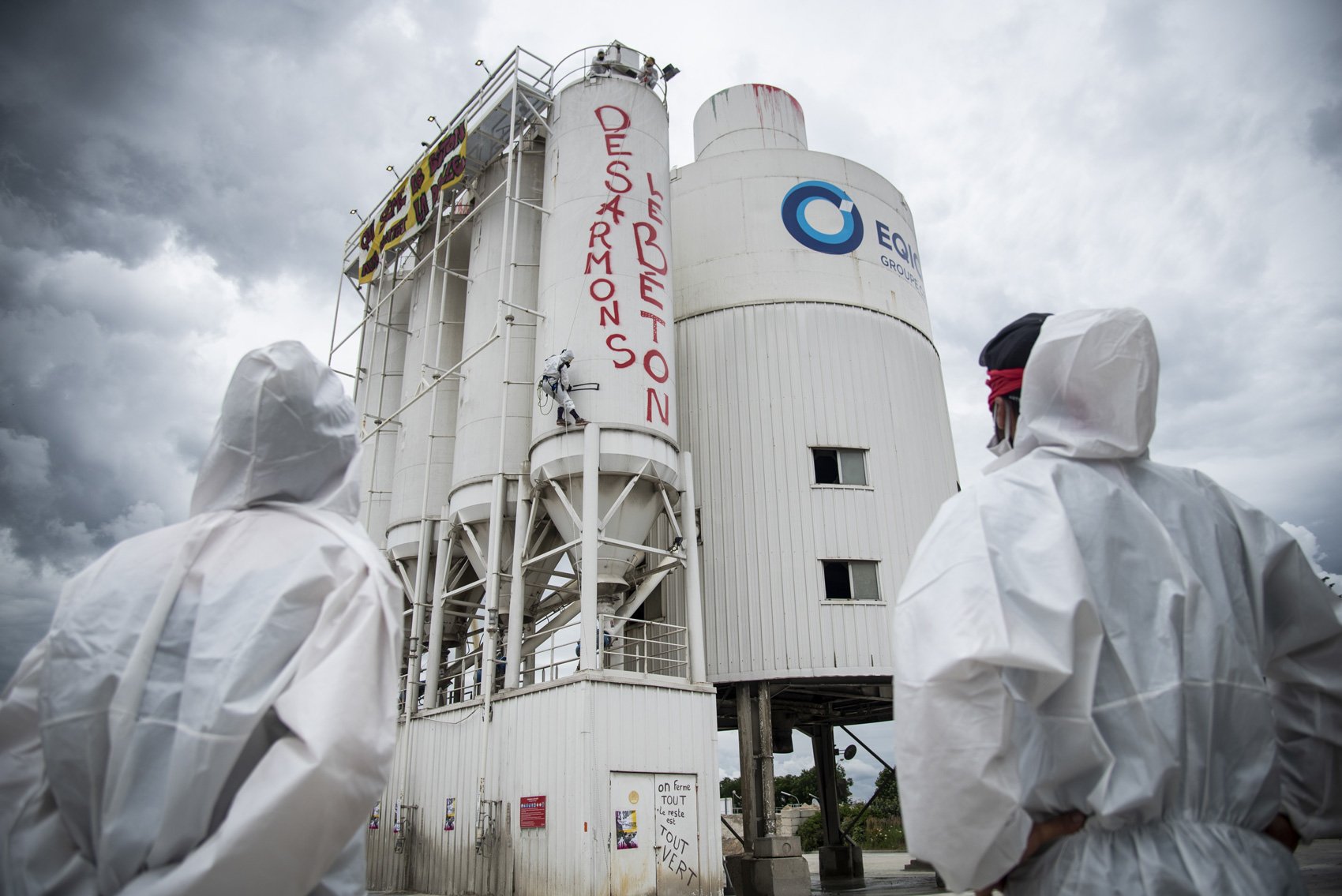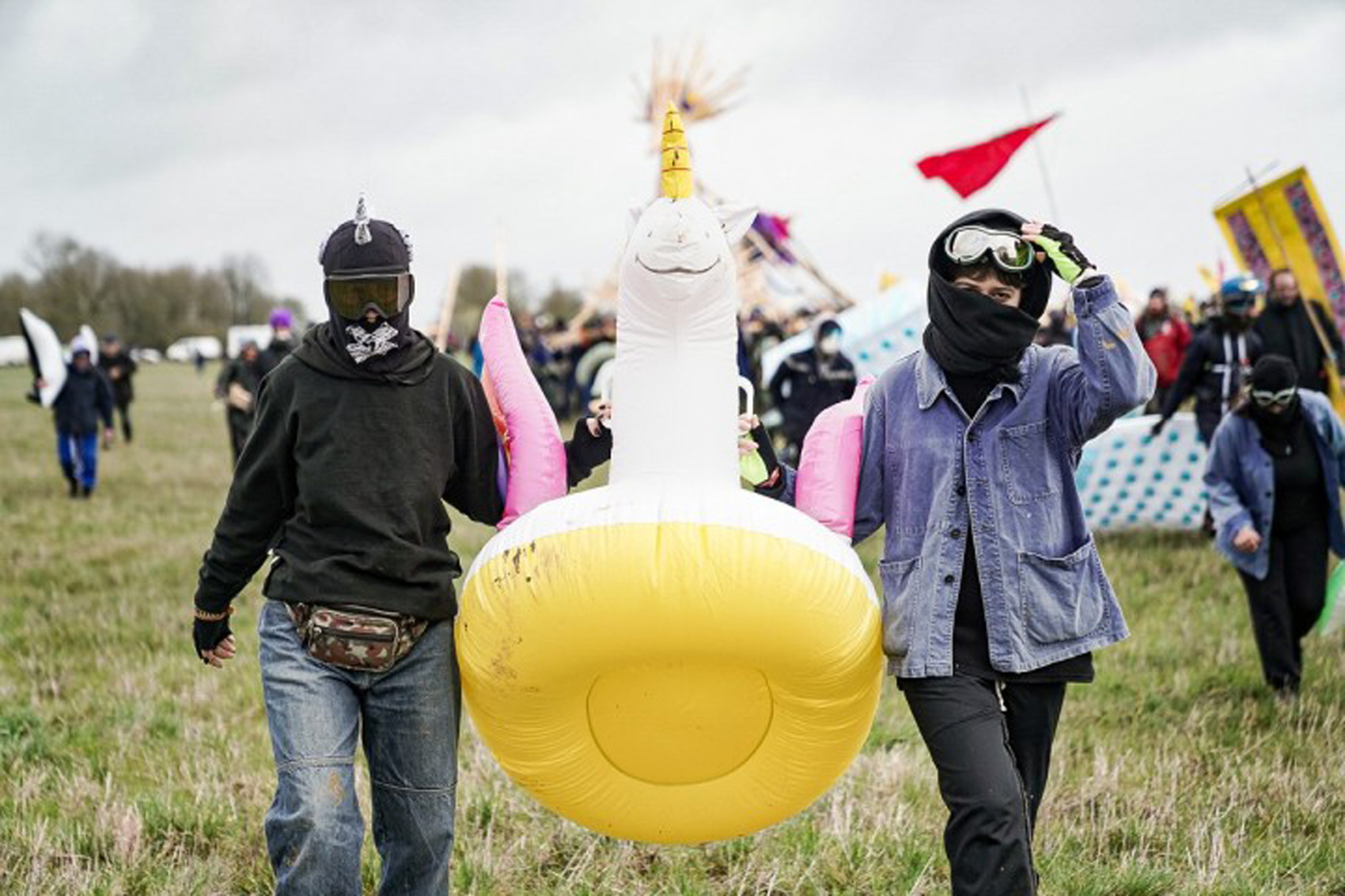Mobilisation against the A69 motorway of Occitania: Territory of new fighting models
- The territory between Tolosa and Castres de Occitania has been the meeting point and struggle of the movement against the A69 motorway between 7 and 9 June. In response to the call of dozens of collectives, 6,000 people have concentrated and gone beyond the ban of Gérard Darmanin, the French Interior Minister. Members of the group Sukar Horia wanted to know the new forms of struggle of the environmental movement that have opened up in the French State in recent years. More specifically, because they find it enriching to know the fight against a motorway in the context of the need to address the fight against the underwater tunnel that the Provincial Council of Bizkaia wants to build from Sestao to Leioa.

In the midst of the ecological crisis, thousands of citizens have reiterated in Occitania the call to paralyse projects that destroy the land following the logic of capital. A total of 6,000 people have been quoted this first weekend in June between the cities of Tolosa and Castres to obstruct the A69 motorway project. The Earth Survey Network, the agricultural union Confederation Paysanne, the collective La Voie Est Libre (La Vía es libre), Extinction Rebellion de Tolosa, the self-managed ZAD centre of the A69 and the GNSA tree protection group have also launched an international call.
Every six months the Earth Survey network is designing activities for the next half a year in assemblies of hundreds of people. The match against the A69 was scheduled in the seventh season. Its objective is to support local struggles and to give a boost to the struggles that are at decisive moments: "Because the works have been launched, because the threat of destruction of the territory is immediate and after exhausting certain forms of mobilisation, offensive forms of fighting must be used". With these goals, the Earth Uprisings movement was created in 2021. This plural movement is made up of climate activists, farmers, trade unionists, autonomous anti-capitalist groups, militants committed to local struggles, ZAD defence zones and other occupied territories.
Three days earlier, the French Minister of the Interior, Gérard Darmanin, announced in the French Parliament the ban on mobilisation against the A69 motorway. Faced with the ban, the Earth Survey network denounced the criminalization of the movement, among other accusations, by classifying as "weapons" material removed from vehicles in random police controls. These materials, among others, were tools to make DIY, knives to cut food or balls to play the petanque. In a statement in which one could read that they would continue with the call, they reaffirmed the call for a "joyful, humorous and resolute mobilization". Immediately, the Confédération Paysanne and GNSA groups appealed for unconstitutionality against the Interior Minister’s decision to abort terrorism.
In the village of Puylaurens, a camp was set up to house protesters on land left by a farmer who opposes the project.
Project drawn twenty years ago
The A69 motorway project linking Castres and Tolosa in Occitania was launched more than twenty years ago. The main driver of the project has been the local bourgeoisie since its inception, led by the pharmaceutical laboratory Pierre Fabre of the city of Castres. The laboratory created in 1962 was growing and from the beginning it was considered strategic to connect the laboratories with Tolosa and from there with the motorway network throughout France. In fact, the confirmation of the project was received by Pierre Fabre during a meal with the Minister of Transport and the European Commissioner for Transport, who until his death was the head of the company. Several elects have told Reporterre that the French president met with the French president, François Hollande, the very night he passed away, to recall the importance of the project.
Today, the tentacles of Pierre Fabre reach almost all aspects of the social life of the region: sports teams, media, elected officials… The relationship between the elects and Fabre is described very well by Alain Veuillet, vice president of the municipality community Sister et Agout, who donated 500,000 euros for the construction of the highway: "Mr. Pierre Fabre encouraged some of his employees to enter municipal policy [...]. He encouraged me [...] to become a councillor of my people. I freed up time to devote myself to it, and I kept on paying the company's wages.
However, not all the inhabitants of the region are in favor of the project, above all because of the ecological impact that it would cause. This 53-kilometre motorway would cut thousands of trees and artificialize 400 hectares of land fértil.El group
La Voie est Libre has developed a project that would be the alternative to the highway: it would use land already expropriated to give space to bicycles and buses, as well as wagering on agroecology. The project, drafted by landscape designer Karim Lahiani, has just received the award from the Ministry for the Ecological Transition. "Isn't it ironic that the same government driving the freeway has given a prize to this alternative? asks Laurent, who is part of the collective.
So far, the mobilizations to paralyse the project have been diverse: demonstrations, hunger strikes, rainforest occupations and cycling marches, among others. As in other parts of the French State, free spaces have also been set up to defend the ZAD. ZADs are occupations performed in defense of environments threatened by a construction site. We can say that the best known has been the Notre-Dame-des-Landes, mounted around 2010 against an airport project in the area of Nantes. After more than a year of fighting, in 2018 they managed to paralyse the airport project and the free space continues.
In the case of the A69 they have also been completed and the main resistance zone currently in operation is Crém'Arbre. There, activists living in the tree houses since February have been facing both police and extreme right-wing attacks. In the days leading up to the mobilisation of 7 to 9 June, the police presence increased considerably on the pretext of archaeological investigations by the company Atosca, which was responsible for the construction of the freeway.
In the last year it has joined the fight against the A69 motorway the Earth Survey and in June it was the third extended call. In the previous two days, about a thousand people joined the mobilizations and managed to occupy the surroundings of the highway works.
The camp, control centre
Thanks to the work of local attendees and the surrounding area, Puylaurens was the epicenter of the mobilizations and actions that took place during the weekend. Already by Friday, thousands of ecologists had started to attend the appointment, after circumventing several police controls deployed in the immediate vicinity. On the way there, you could see the construction sites started on the A69 highway along the road. In one building area, the entire excavator and the works trucks could be stacked in one area. The police, armed, guarded the area day and night. At the entrance to the camp, while a tractor conditioned the ground for the weekend event, the militants helped the newly arrived cars to park.
The tents that would host concerts and round tables, the stands of numerous collectives, the toilets, the bar and the canteen with the capacity to feed thousands of people completed the central area of the camp. In addition, the reference points of the different groups that formed the Arrière base [rear] of the movement could be found: doctors, a group against systemic oppression – racism, sexism, queerphobia, capacistism and others –, a space of psycho-emotional support and a group of lawyers and legal support lawyers. Its objective is to organize a "collective care response" to the repression that isolates and individualizes. The Arrière bases of the protest organized by the Earth Uprising in Sainte-Solín on March 25 define its action in a passage of the book On ne dissout pas un soulèvement (An uprising does not disrupt): "We don't want to assign care to specialized organizations, we want to build a collective care practice in our struggles. The way of life of repressive situations is unique to each of us. This can lead us to individualize and isolate our experiences. Therefore, in our spaces, the transversality of care allows us to place our individual experiences in a political and collective context".
To avoid their identification, the license plates of the covered cars and some members of the camp with their faces covered remembered the campaign of criminalization and repression against the network undertaken by the Earth Uprising. As the members of the movement say, "due to the dimension that the Earth Treasury has acquired, the alliances built, the extent of mobilizations, the public holidays, the blockade, occupation and disarmament, a term used to refer to the mass sabotage against toxic infrastructures, the movement has become a threat to the industrial power and the policies of the State". In this regard, it is worth recalling the violence perpetrated by the police against demonstrators, the arrests of members and the French Government’s attempt to outlaw the movement in 2023.
On Friday scheduling, workshops, round tables, marches and projections completed the afternoon and night. At the end of the day, the concerts and a drag performance animated the camp. Still at night, those who slowly arrived at the camp set up shops in the dark. Thousands of people came from different parts of the state, as well as from Catalonia, Italy, Sardinia and the Basque Country.
Day of mobilisation, facing repression
By Saturday morning, the sun heated the camp. The police helicopters had been monitoring the land since the morning. At 04:00 in the morning of yesterday, a helicopter fired the participants, flying near the camp and with a light bulb, illuminating the tents.
In anticipation of the repression, a workshop was offered during the demonstrations to deal with police attacks on a corner of the camp. Organized into affinity groups, the grenade thrown by the Police was a basic training to protect against tear gas grenades and GM2L. The ghost of repression is very present among the members of the Earth Uprising network. The experiences of police aggression with savage violence in the city of Sainte-Soline have become an unforgettable movement. On 25 March 2023, the Earth Treasury organized a demonstration in Sainte-Soline against the large birches that privatize water for the agro-industrial industry. The police launched 5,000 grenades against a mass demonstration of 30,000 people. They caused more than 200 injuries, including 40 in severity, two of them between life and death. Following these events, on 28 March, Interior Minister Darmanin announced that the Earth Uprising would declare it "eco-terrorist" and outlaw the movement. On 21 June, the movement in the United Kingdom was dissolved. Then came the arrests against its members, as well as the wave of solidarity in favor of the network of Earth Uprisings. Finally, the ban was lifted by the State Council on November 9, 2023. However, as has been said, the State apparatus continues to criminalize the movement, continue to harass mobilizations with police violence and continue to outlaw calls. Proof of this was the repression that took place during the mobilization of the first weekend of June.
Also outside the organized workshops, advice to protect themselves from grenades was discussed and discussed throughout the camp. One of these explanations was that of a colleague who "knew Rémi Fraisse, killed near here ten years ago." The 21-year-old ecologist militant was killed in a mobilisation against the construction of the Sivens dam on 26 October 2014 with the explosion of an offensive grenade launched by the police. After this terrible event, the French State banned the use of this type of grenade during the demonstrations in France.
At noon, the calls for the mobilizations offered a press conference in Bilbao. The shooting and taking of photos were prohibited in the camp: the journalists who accessed the camp received the images with the consent of a person from the organization to ensure the security of the mobilized. The tension between the media that criminalize the movement and the environmentalist militants was evident in those days. The Earth Uprising denounced the "shameful media treatment" of weekend demonstrations on 7 June in a statement. Media such as CNEWS, Le Figaro, Europe 1 or La Dépêche reported that "lies and manipulations were spreading" by the Interior Minister, Tarn Prefecture and intelligence services. The communiqué also referred to the concept of "spectacularly violence", developed by the environmental movement in its book Premières secousses (First Manifestations). With this, the media explain the treatment of the movement, constantly linking the movement with violent images.
Organized by blocks
The demonstration started at 14:30 in the afternoon, divided into four blocks, each with a different color. The first is the yellow bloc, made up of the farmers and inhabitants of the ZAD. The second, the pink bloc, a cheerful and vindictive group led by queer feminists. The third is the green block, which the blue blocks called the attention of the police to carry out the facts, and finally the blue block, formed with the aim of carrying out disarmament actions dressed in black. The hum of Tekno's music was heard as the blocks developed. All in all, each block took its way, shouting "À bas l'état policier" (the end of the police state) and "No macadam" (the game of words between No Pass and macadam). The yellow blocks had placed a trailer in the middle of the route, with the aim of preventing an armored convoy from passing through the place and protecting the rest of the protesters. The rest of the blocks, each on their side, traveled through the forests and the prairies. Some citizens greeted the protesters and offered them water.
After a few hours of work, the pink, green and blue block was concentrated in the vicinity of the village of Appelle. Disarmament action against the A60 motorway was to be carried out in these areas. However, the Police quickly occupied the place through the attacks and the objectives of the action could not be realized. At that time, there were clashes between police and demonstrators in the wheat fields across the village. According to the organizers, 40 protesters were injured by GM2L grenades and three of them had to be transferred to a hospital center with contusions of different consideration. The cars that led to the wounded were blocked on several occasions by the police. According to the organizers, an ambulance heading for the camp was blocked by the police for more than an hour. According to Tarn Prefecture, two police officers were injured and three police vehicles were destroyed.
At the end of the demonstration, the demonstrators took the path of the camp and headed towards it. Once in the shelter, one could see a bittersweet sensation among the participants. On the one hand, the joy was that, as the demonstration was illegal, and overcoming the fear of the repression that the mass media disseminated in the previous days, 6,000 protesters came together. On the other hand, there was frustration at the consequences of this fear of repression that spread through the media and because fewer people had gathered than expected.
Once again, the Earth Treasury denounced the violence perpetrated by the police against an environmental demonstration as soon as the demonstration was completed. The network stressed that GM2L grenades are weapons of war and recalled the words of the UN Special Rapporteur, Michel Forst, regarding police violence by the French State: "France is one of the European countries that has exercised the most police repression against environmental activists as a whole. Police violence comes from another world. Their foreign counterparts do not understand how the French react to the demonstrations, do not understand that so much violence can be used".
Once again, the festive atmosphere invaded the camp again on Saturday night with concerts. Some were immersed in a festive atmosphere, others rested. A comprehensive programme had already been prepared for the following day: round tables, formations, spectacular events, cycling to the ZAD and meetings of the local committees of the Earth Uprisings Network. In the camp there was a desire to help the ZAD: "We have to go release the ZAD this weekend, we have to get the police out there," a National Police activist warned.
Following all weekend demonstrations, the organizers stressed the importance of continuing to fight the A69 motorway and the world it represents: "We have to learn more than ever to defend ourselves together from police violence, and continually reinvent the forms of resistance that eco-incident projects are going to suffer," he added.
The camp, which during those days had been a meeting place, shelter and resistance centre, was dismantled in the following days. The protest ended on the weekend, but the fight against the A69 Highway came out with new nudges and new forces since the first weekend of June. Beyond that, from the Sukar Horia group, we hope that this rebellion born with the objective of curbing the capitalist plunder of the lands, of our living environment and of our relations, will be a future full of victories.
Outside the police state! They sing through the explosions of tear gas. Committed young people, amateur militants, covered faces, or not, clowns, musicians, trade unionists and politicians, doctors with a helmet, farmers on tractors... Both in the countryside and in the city,... [+]
The French State Council has decided that the Earth Survey should eliminate the destruction of the network. Although it is confirmed that this movement causes "violence against goods", the legalization would not be "an appropriate, necessary and adapted measure". It is good news for... [+]
Duela astebete hamabost ekintzaile ekologista atxilotu zituen Poliziak, Frantziako zuzendaritzaorde antiterroristaren aginduz. Horietarik bi euskal herritarrak ziren, baiones bat eta hendaiar bat, biak Tolosan bizi direnak.























